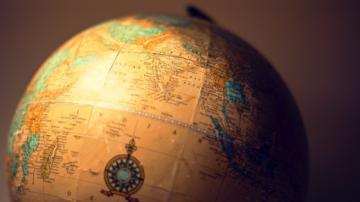Consider the evolution of humankind. When we do, we will recognize that having global discussions and acting on global decisions is a relatively new phenomenon—only 100 years old, give or take a few years. We're still learning how to make global decisions and execute on them successfully.
Yet our ability to improve those globally focused practices and skills is critical to our continued survival. And open principles will be the keys to helping us learn them—as they have been throughout history.
In the first part of this series, I reviewed four factors one might use to assess globalization, and I explained how those factors relate specifically to open organization principles. Here, I'd like to present a chronology of how those principles have influenced certain developments that have made the world feel more connected and have made personal or regional issues into global issues.
This work draws on research by Jeffrey D. Sachs, author of the book The Ages of Globalization. Sachs examines globalization from the genesis of humankind and argues that globalization has improved life and prosperity through the ages. He organizes human history into seven "ages," and examines the governance structure predominant in each. That structure determines how populations interact with each other (another way of assessing how socially inclusive they are). For Sachs, that inclusiveness is directly related to per capita GDP, or productivity per person. That productivity is where prosperity (or survival) is determined.
So let's look at the growth of globalization through the ages (I'll use Sachs' categorizations) and see where open organization principles began to take hold in early civilizations. In this piece, I'll discuss historical periods up to the beginning of the Industrial Revolution (the early 1800s).
The Paleolithic Age (70,000‒10,000 BCE): The hunter/gatherer setting
According to Sachs, the history of globalization really begins at the dawn of humankind. And open organization principles are evident even then—though only in tight-knit groups of 25 to 30 members, called "bands," each very similar to "bottom-up" business teams today. Such bands resisted hierarchical organization, eventually connecting with other bands to form "clans" of around 150 people, then "mega-bands" of around 500 people, and finally to "tribes" of around 1,500 people. But these groups never let go of that "band" concept (we can observe this in ancient ruins around the globe). Bands cooperated, but interactions were relatively weak (sometimes even warlike, as bands fought to protect territory). As bands' means of survival was primarily hunting and gathering, they lived a largely nomadic lifestyle.
The Neolithic Age (10,000‒3,000 BCE): The ranching/farming setting
The advent of farming and ranching, Sachs says, marked this period of globalization. During that period, major segments of the human population started establishing permanent settlements, leading to decline in the hunter and gatherer nomadic lifestyle, as agricultural developments allowed for more productivity per unit area. People could establish larger villages. With new agricultural techniques, ten individuals could survive on one square kilometer of land (compared to only one person per square kilometer of hunter/gatherers). Therefore, people were not forced to migrate to new areas to survive. Communities grew larger, and these larger communities set in motion new technical discoveries in metallurgy, the arts, numeric record keeping, ceramics, and even a writing system to record technical breakthroughs. In short, sharing and collaboration became keys to expanding know-how, evidence of open organization principles even tens of thousands of years ago.
The Equestrian Age (3,000‒1,000 BCE): The land travel by horse setting
During the Neolithic Age, communities began connecting with each other using horses for transportation, giving rise to another era of globalization—what Sachs calls The Equestrian Age. Domestication of animals took place almost exclusively in Eurasia and North Africa, including the use of donkeys, cattle, camels and other animals (not just horses). That domestication was by far the most important factor in the economic development and globalization in this age. Animal husbandry was a major influence on farming, mining, manufacturing, transportation, communications, warfare tactics, and governance. As greater long-distance movement was now possible (routes were formed to and from the east and west), whole civilizations began to form. The Egyptians introduced a system of writing and documentation, as well as public administration, which unified dynasties within the region. This led to advances in scientific fields, including mathematics, astronomy, engineering, metallurgy, and medicine.
The Classical Age (1,000 BCE‒1500 CE): An information, documentation, learning setting
According to Sachs, this era of globalization involves the globalization of politics—namely conquering wide regions and creating empires. This includes the empires of Assyria, Persia, Greece, Rome, India, China and later the Ottoman and Mongol empires. This age saw the spread of ideas, technology, institutional concepts, and infrastructural development on a continental scale. As a result, larger communities were developed, and there was a greater and broader level of collaboration, interaction, transparency, adaptability and inclusivity than in the past. Through interaction between empires, better methods of growing food, raising farm animals, transporting goods and fighting wars spread around the globe. Much of this knowledge spread through thousands of books published, distributed, and taught (formal, community schooling began in this era, as did several documentation practices). Global trade improved with the establishment of a navy to police and protect travel routes. Simply put, this was a setting of multinational governance with ever expanding collaboration, inclusivity, and larger community development.
The Ocean Age (1500‒1800 CE): The long-distance sea travel and exploration setting
During this period of globalization, Sachs says, the Old World and the New World, isolated from each other since the Paleolithic Age, finally united through ever faster ocean-going vessels, leading to greater two-way exchange. Plants, animals—and, unfortunately, diseases and pathogens—trafficked between them. Travel from Europe to Asia (via the Cape of Good Hope) increased during this era. This age saw the rise of global capitalism, with the establishment of global-scale economic organizations, like the British East India Company (chartered in 1600) and the Dutch East India Company (chartered in 1602). Each supplied global markets with goods from remote areas. But while global trade produced great prosperity during this era, in many regions it also led to great cruelty (the exploitation of indigenous peoples, for example).
By the 1800s, communities were interacting on a scale more global than it had ever been, and open organization principles were more influential than ever before. And yet this era still saw a significant deficit of overall inclusivity and collaboration. We should note that this era of globalization is relatively recent in history when viewed on the timescale Sachs outlines in The Ages of Globalization.
How did we get from there to the current age? In the next article, I'll explore those developments.







1 Comment